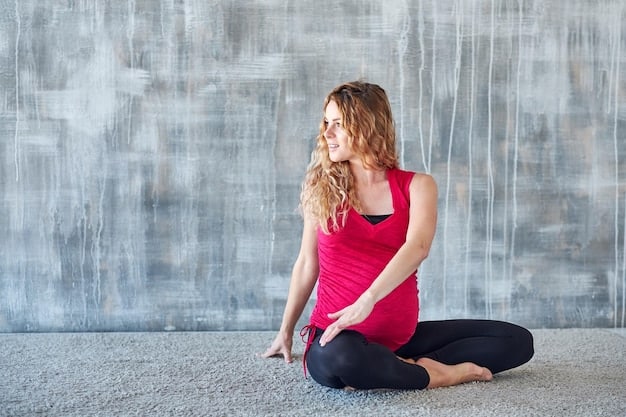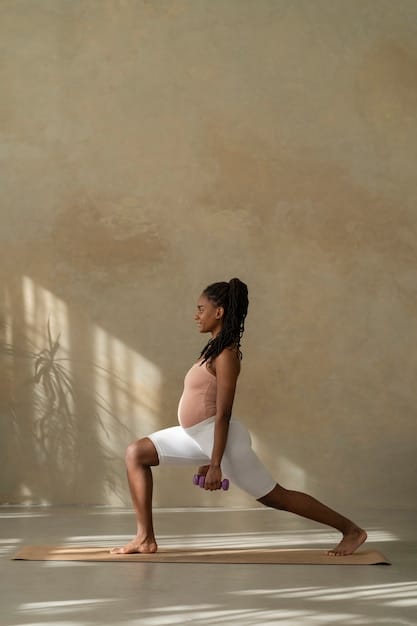Yoga for Pregnancy: Safe Poses for Each Trimester (2025 Guidelines)

Yoga for Pregnancy: Safe and Effective Poses for Each Trimester, Updated for 2025 Guidelines is a gentle exercise that offers numerous benefits by improving strength, flexibility, and relaxation during the gestation period, helping to ease common pregnancy discomforts and promote overall well-being for both mother and baby.
Embarking on the journey of motherhood is an exciting time, and incorporating safe exercises like yoga can be incredibly beneficial. Yoga for Pregnancy: Safe and Effective Poses for Each Trimester, Updated for 2025 Guidelines provides a gentle yet effective way to enhance your physical and mental well-being throughout your pregnancy.
Understanding the Benefits of Prenatal Yoga
Prenatal yoga goes beyond just physical exercise; it’s a holistic practice that supports your body and mind during pregnancy. Understanding these benefits can motivate you to integrate yoga into your routine safely and effectively.
Physical Benefits
Yoga poses enhance flexibility, strength, and balance, addressing the physical demands of pregnancy. These physical improvements help alleviate discomfort and prepare your body for labor.
Mental and Emotional Benefits
Beyond the physical aspects, prenatal yoga is wonderful for improving mental health. Using it can decrease stress and boost relaxation thus leading to overall mental wellness.
- 🧘♀️ Reduces stress and anxiety.
- 😊 Improves mood and emotional balance.
- 😴 Promotes better sleep quality.
- 🌬️ Enhances mindfulness and relaxation techniques.

In conclusion, prenatal yoga offers a comprehensive approach to enhancing physical comfort, emotional well-being, and mental clarity. By consistently practicing yoga, expectant mothers can better navigate the changes and challenges during this special time.
Essential Guidelines for Practicing Yoga During Pregnancy
Safety is paramount when practicing yoga during pregnancy. Adhering to specific guidelines ensures that you and your baby remain safe throughout each session.
Consulting with Healthcare Providers
Always seek guidance from your doctor or midwife before starting prenatal yoga. This step is essential to ensure you’re clear to participate based on your individual health profile.
Modifications for Pregnancy
Adjusting poses to accommodate your growing belly is vital. Use props like blocks and bolsters for support, and avoid lying flat on your back after the first trimester.
- 🚫 Avoid poses that compress the abdomen.
- 🤰 Use props for support and balance.
- 🧘 Modify movements to eliminate strain.
Following these guidelines offers a safe and supportive yoga practice throughout your pregnancy. Prioritizing personalized advice and mindful adjustments ensures a positive experience for both mom and baby.
First Trimester Yoga: Gentle and Restorative Poses
The first trimester can be both exciting and challenging as your body undergoes significant changes. Focus on gentle, restorative poses that nurture your body and ease early pregnancy symptoms.
Supported Child’s Pose (Balasana)
Ideal for relaxation and reducing fatigue, Supported Child’s Pose allows for rest without compressing the abdomen. Use a bolster for added comfort and support.
Seated Mountain Pose (Parvatasana)
Enhance posture and promote gentle stretching seated Mountain pose encourages a focus breathing and creates a sense of calm.
- 🧘♀️ Sit comfortably with your legs crossed or extended.
- 👐 Raise your arms overhead, palms facing each other.
- 🌬️ Inhale deeply, lengthening your spine; exhale relaxing your shoulders.

In summary, opting for a gentle yoga practice during the first trimester will support your journey. These restorative poses boost both your physical and emotional health, encouraging wellbeing.
Second Trimester Yoga: Incorporating Movement and Strength
As energy levels often increase in the second trimester, you can gradually introduce more active poses while continuing to prioritize safety and comfort. Listen to your body and avoid overexertion.
Modified Warrior Two (Virabhadrasana II)
Strengthen your legs and improve balance with Modified Warrior Two. Widen your stance and ensure your front knee is directly over your ankle.
Cat-Cow Pose (Marjaryasana to Bitilasana)
Improve spinal flexibility and relieve back pain with Cat-Cow Pose. Coordinate your breath with your movements, arching your back on the exhale and rounding it on the inhale.
- 🐾 Start on your hands and knees, aligning your wrists under your shoulders and knees under your hips.
- 😺 Inhale, drop your belly, and lift your chest and tailbone (Cow Pose).
- 😼 Exhale, round your spine, tuck your chin to your chest, and draw your tailbone in (Cat Pose).
In conclusion, as you move into the second trimester, feel free to mindfully infuse movement and strength training elements into your yoga routine. Remember all the time on comfort and safety.
Third Trimester Yoga: Focus on Comfort and Relaxation
In the third trimester, focus on poses that promote comfort, relaxation, and preparation for labor. Slow, deliberate movements combined with deep breathing are beneficial.
Supported Triangle Pose (Trikonasana)
Supported Triangle Pose helps stretch your sides and open your chest while maintaining stability. Use a block under your hand for added support.
Gentle Hip Openers
Prepare your body for labour with gentle hip openers. These poses will promote flexibility and relaxation within the pelvic area.
- 🧘♀️ Practice seated hip circles.
- 🧘♂️ Use a bolster.
- 🌬️ Breathe deeply.
To summarize, as you enter your third trimester, consider adapting your yoga routine to support ultimate comfort and readiness for the labour . Concentrate your efforts on cultivating inner peace.
Postnatal Yoga: Rebuilding Strength and Promoting Recovery
Postnatal yoga supports physical recovery, emotional well-being, and re-establishing core strength after childbirth. Start slowly and gradually increase intensity as your body heals.
Pelvic Floor Exercises
Rebuild pelvic floor strength with gentle exercises like Kegels. These exercises help improve bladder control and support pelvic organ function.
Gentle Backbends
Relieve postpartum back pain with gentle backbends. These poses help strengthen the muscles along the spine and counteract rounded posture from breastfeeding and caring for your newborn.
- 💪 Strengthen postural muscles.
- 😌 Lower stress.
- 🧘 Improve flexibility.
| Key Point | Brief Description |
|---|---|
| 🤰 Safety First | Consult your doctor before starting prenatal yoga. |
| 🧘♀️ First Trimester | Focus on gentle, restorative poses like Supported Child’s Pose. |
| 💪 Second Trimester | Incorporate movement and strength with poses like Modified Warrior Two. |
| 😌 Third Trimester | Prioritize relaxation and comfort with poses like Supported Triangle Pose. |
Frequently Asked Questions (FAQs)
▼
Prenatal yoga is generally safe during all trimesters, but it’s essential to consult with your healthcare provider before starting. Modifications are necessary to accommodate each stage of pregnancy.
▼
Avoid poses that compress the abdomen, deep twists, inversions, and lying flat on your back after the first trimester. Listen to your body and modify as needed.
▼
Yes, prenatal yoga can prepare your body and mind for labor and delivery. It improves strength, flexibility, and mental focus, which can be beneficial during childbirth.
▼
Aim for at least 2-3 times a week to experience the benefits of prenatal yoga. Consistency is key, but always listen to your body and adjust the frequency based on your energy levels.
▼
Postnatal yoga helps rebuild strength, promotes recovery, and supports emotional well-being after childbirth. It focuses on pelvic floor exercises, gentle backbends, and relaxation techniques.
Conclusion
Embracing Yoga for Pregnancy: Safe and Effective Poses for Each Trimester, Updated for 2025 Guidelines not only promotes physical health but also nurtures mental and emotional well-being during this transformative journey. By following mindful adjustment and the guidelines, you can enjoy a harmonious pregnancy.





